'Round and 'round we go - men and women, cheek to
cheek. But are we dancing or circling each other in the ring? We follow the steps and move
to the rhythm when suddenly POW! - a left hook to the sensibilities. Shaking our heads, we
quickly look around to see where the blow came from, but our partner just smiles
inquisitively and asks us what is wrong. Convinced it was some inexplicable phenomenon, we
snuggle up again to dance when BAM! - a stiff upper-cut to the heart! Now we're SURE
something hit us, but our partner hasn't moved. We spin wildly around to discover who
dealt us the blow, but there's no one else in sight. Where did the attack come from? The
dead center of our blind side, and we never saw it coming.
Each of us has blind sides. It is easy to see why.
Our conscious minds focus our thoughts on the topic at hand. A by product of focusing our
attention in one place is that we are putting less attention somewhere else. After a time,
we can get so used to looking at things one way, we forget there is another point of view
at all. This kind of blind side is shared by men an women.
In addition, there is another kind of blind side
that does not come from experience. In fact, it occurs naturally in an area so
basic and so close to home that we even have trouble admitting it might actually exist.
This super blind side is the mental difference between the sexes.
Men and women really do think differently.
Historically, this has been assumed, and in recent days, many scientific studies have
proven this beyond doubt through medical and statistical studies:
Biologically we are finding differences in the
brains of men and women. One of the most notable is an inequality in the size of the
Corpus Collosum, which is a band of nerves that connect the two sides of the brain. The
Corpus Collosum of women is larger, leading (according to recent theories) to a more
balanced use of the left and right sides of the brain by women, while men tend to
concentrate their energies on one side or the other, depending on the task.
We are also learning much more about psychologic
differences in the environments in which men and women grow from children to adults.
Looking toward the past, it is clear that social roles were assigned primarily on the
basis of biologic sex. Boys were taught and allowed to experience one set of things, and
girls another. Quite naturally this kind of conditioning leads to two completely different
sets of responses. In today's world, even with all the moves made toward equality, the
modern media of television, movies, and music, continue to portray girls as nurturing,
boys as rough and tumble; women as sex objects and men as goal driven.
Clearly, mental sex differences exist. The real
question is: "Where do they come from: biology or society?" As it turns out, the
answer to this question also provides a model for the creation of sex-specific blind
sides. To see how, we'll need to examine the nature of self-awareness itself.
The Nature of
Self-Awareness
To be self-aware, we must be able to look at our
"selves." We like to believe we can be objective about this. In truth, we can't
really step outside of our own minds to see what kind of a person we really are. Instead,
we must examine our minds from the inside. We must look at our minds while we are using
our minds. The problem is, we can't look at the part we are using while we are using it.
There is a part of ourselves that goes unseen
because it is busy doing the looking. As a result, we can see some parts of ourselves as
clearly as anyone else, and often better than anyone else. Still, as we get closer and
closer to the center of our being, we see less and less clearly. Eventually, there comes a
point where we see nothing at all. The most hidden part of ourselves is our own point of
view.
The closest we can get to a complete view of
ourselves is to examine our mind from one point of view, then shift our point of view to
evaluate the ground on which we were previously standing. We might see how we think about
how we feel, and then get a feeling for how we think. We might re-evaluate our initial
reaction to a situation in terms of past experience, or re-evaluate our previous
assumptions about a situation based on new information. Eventually, we will have gone
round robin in our own heads and come to believe we have a pretty good idea of who we are.
This is so basic to self-awareness, most of us do it as naturally as breathing. It is
usually an unconcsious process that provides us with an ongoing sense of self, and only
comes to our attention when some problem we encounter suggests we better take a good look
at ourselves.
Still, trying to catch a glimpse of our true selves
is the mental equivalent of chasing one's own tail. The very process of considering
ourselves, changes our point of view. So, when we jump to a new point of view to look at
the old one, we are not seeing what it was, but what it is. There is no simultaneous,
complete, and objective view of ourselves avaiable. So, just like our dancer/boxers,
'round and 'round, round by round, we go.
Male and Female
Differences
in Blind Sides
The previous section briefly describes how blind
sides are created in a psychological sense. If this were the extent of it, there would be
no differences between the sexes. Rather, each of us would develop a slightly
different method or of examining oneself, based on personal experiences. But, underneath
all of the methods of self-awareness that make us unique is one that makes us the same. It
is the biologic foundation of self-awareness itself, and it comes in two flavors:
Space and Time.
Space and Time are two of the most important
perceptions we have about the world in which we live. Our space sense tells us how things
are arranged, and allows us to find meaning in patterns. Our time sense tells us what
processes are at work, and allows us to anticipate.
You've probably heard that men are "spatial
thinkers". That's why, statisically as a group, they are good at maps and parallel
parking. What you probably havent' heard is that women are "temporal thinkers",
though that's why they are generally good at things that require time to develop, such as
relationships, and also at getting a sense of where things are headed (often called
"intuition").
Although exaggerated and idealized by society, the
spatial and temporal differences between men and women have their roots in very real
differences in the biologic foundations of self-awareness between the sexes. It all stems
from the effect of hormones on our brains before we are born.
Between the 12th to 14th week of pregnancy, there
is a flush of testoserone over the brain of a developing male fetus. This flush is absent
in the female fetus. Testosterone causes the brain to manufacture more Seratonin (a
powerful neurotransmitter that causes the neurons in the brain to become more active. It
also has a second effect. The brain's neural networks , called ganglia, contain two
very special kinds of cells: L cells and R cells. It is suspected that one
of those kinds of cells makes Seratonin, and the other makes Dopamine. Dopamine is
something of an opposite to Seratonin, and works to calm the neuro networks of the
ganglia. Estrogen in the bloodstream causes a greater amount of Dopamine to be created in
the brain. A testosterone wash during that 12th to 14th week of the brain's development
causes a balance to be set between the L and R cells. Once set, it is locked in place for
life, and determines the relative influence of Seratonin vs. Dopamine on the ganglia.
Because Seratonin excites neurons, the neurologic
part of a male's brain takes the driver's seat, and the biochemistry becomes the
passenger. But in a female brain, the balance is reversed. The biochemistry takes the
driver's seat and the neruology is along for the ride. Neruology is binary because the
neurons works like little transistors that are either firing or not. The biochemistry is
more holistic. It fluctuates over time creating patterns of currents and eddies. From the
neurology we get our sense of logic. From the biochemistry we get our sense of emotion.
Men have both, women have both, but one is the driver and one the passenger.
All of our upbringing and training can serve to
support, counterbalance, or overcome our pre-birth bias toward space or time, but it
cannot undo it. So, all of our methods of self-awareness that are cutlurally indoctrinated
or arrived at through our personal experiences define our personalities, but the method
determined in the womb defines our Mental Sex. It is not surprising then, that while any
individual, male or female, may prove to be better at math, science, nurturing, or
relationships, statistically there is a measurable difference between the sexes in spatial
and temporal skills.
Society and Mental
Sex
Societies that take advantage of these statistical
differences by creating spatial and temporal roles for its members based on their
anatomical sex have a much better chance to survive, for specialization enhances the
efficiency of society as a whole. Unfortunately, specialization also requires stringent
guidelines which are often confining for the individual. Almost like a magnetic force,
individuals are attracted to and repelled from engaging in certain behaviors deemed
appropriate or inappropriate by the collective organism of society through peer pressure
and economic consequences.
In addition, individuals pick up the signals that
constitute cultural indocrination from the moment they are born. And, as a result, not
only is behavior molded into "acceptable" standards, but even more subtley, our
psychologies are molded as well. The biologic basis of the differences between the sexes
is enhanced and widened until our inherant blind sides are combined, blended, and
overwritten with many other conditioned. In the end, modern men and women owe their
personalities to a biologic foundation, overlayed with cultural indoctrination, refined by
personal experience, and decorated by personal choice.
Taken together, all of these influences allow us to
sense the reality in binary generalizations about mental differences between the sexes,
yet accept the notion that any given individual falls somewhere along a spectrum between
the two.
The world in which we live offers rewards for both
spatial and temporal thinkers. In fact, both kinds of rewards overlap to some extent, as
illustrated in the picture above. Many of the desirable situations and experiences life
has to offer contain both spatial and temporal elements or aspects, and are
therefore attractive to both mental sexes, though for different reasons. Still, there are
parts of what life has to offer that are of interest only to spatial thinkers and those of
interest only to temporal thinkers.
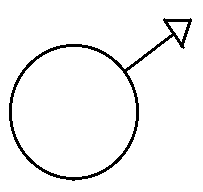 Generally, men tend to know what they want. If they don't, it is
usually because there is more than one thing they want, and they are having trouble
deciding among them. This refelects the binary foundation of a spatial mental sex. Until a
decision is made, a man will not usually act. Now this is not to say that men don't ever
act emotionally, but simply that even when they do, they are reacting to something specific
that thrills or bothers them.
Generally, men tend to know what they want. If they don't, it is
usually because there is more than one thing they want, and they are having trouble
deciding among them. This refelects the binary foundation of a spatial mental sex. Until a
decision is made, a man will not usually act. Now this is not to say that men don't ever
act emotionally, but simply that even when they do, they are reacting to something specific
that thrills or bothers them.
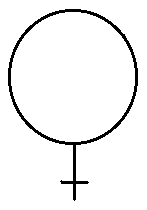 Generally, women know what they like or dislike at the moment, but
also realize those feelings may change dramatically over time. This reflects the process
foundation of a temporal mental sex. As a result, women need to explore an issue or a
situation over time to see how it feels (or put more subjectively, how she feels about
it). Only when a sense of the processes and directions involved becomes clear can she feel
confident in making a long-term emotional decision.
Generally, women know what they like or dislike at the moment, but
also realize those feelings may change dramatically over time. This reflects the process
foundation of a temporal mental sex. As a result, women need to explore an issue or a
situation over time to see how it feels (or put more subjectively, how she feels about
it). Only when a sense of the processes and directions involved becomes clear can she feel
confident in making a long-term emotional decision.
For both men and women, as we go through life
trying to find and enjoy rewards (and avoid costs) we find ourselves passing through a
jungle of decisions requiring logical and emotional exploration, as illustrated below.
Along the way, we search for a glimpse of those things that are meaningful to us as
spatial and temporal thinkers. When we do, we move in the direction of that which we seek.
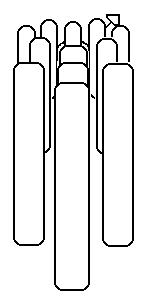
Both men and women may begin at the same place, but
men are looking toward their goal, while women are determining theirs.
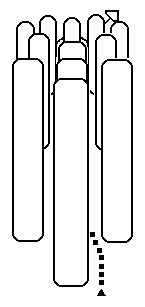
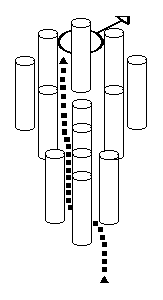 Men seek the quickest, most efficient path from point A to point B,
hoping to close in on their goal or the object of their desire in a consciously directed
effort. Life puts many obstacles between us and our desires, however, so men often find
themselves having to change course, which may lead to inefficiencies along the way.
Men seek the quickest, most efficient path from point A to point B,
hoping to close in on their goal or the object of their desire in a consciously directed
effort. Life puts many obstacles between us and our desires, however, so men often find
themselves having to change course, which may lead to inefficiencies along the way.
 In the end, barring any immovable obstacles or the appearance of
other, more desirable goals, a man will eventually reach his destination. Often, he cannot
appreciate the true cost he has experienced in his quest until he achieves his goal and
then figures up the tally sheet: was it worth it? By properly selecting goals and being
aware of mounting costs, a man can establish a very positive success rate in getting what
he wants.
In the end, barring any immovable obstacles or the appearance of
other, more desirable goals, a man will eventually reach his destination. Often, he cannot
appreciate the true cost he has experienced in his quest until he achieves his goal and
then figures up the tally sheet: was it worth it? By properly selecting goals and being
aware of mounting costs, a man can establish a very positive success rate in getting what
he wants.
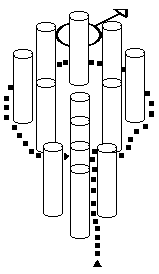 From a male point of view, it often appears that women take an
inefficient, meandering approach, and worse yet, often miss the goal entirely! In fact,
they seem to be running around in circles for no apparent reason. The problem in
understanding is that women are not primarily driven by "reason", but by
emotion. This is not to say that women cannot be "reasonable", but simply that
reason is not the most important evaluation.
From a male point of view, it often appears that women take an
inefficient, meandering approach, and worse yet, often miss the goal entirely! In fact,
they seem to be running around in circles for no apparent reason. The problem in
understanding is that women are not primarily driven by "reason", but by
emotion. This is not to say that women cannot be "reasonable", but simply that
reason is not the most important evaluation.
Men generally have trouble accepting that when the
cards are down, logic should not have the final say. For women, however, simply making
sense may not be enough. In fact, reason to women takes the same position as emotion does
to a man. Yes, it is important, but only as a context in which to evaluate emotion. Men
tend to see this as a woman's handicap, and have trouble accepting that a view of life
that sees emotion as being most important is just as valid, efficient, and practical as
theirs, and in half of life's situations will prove more appropriate and effective.
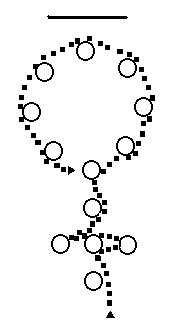 In fact, women don't share the same kind of goal appreciation as men,
and therefore are not really headed for the same thing at all. Men, dealing primarily from
a spatial, logical point of view, cannot imagine another kind of "goal" that
might be as important. If they could, however, they would see that the female approach is
absolutely the most efficient for arrirving at this alternative destination.
In fact, women don't share the same kind of goal appreciation as men,
and therefore are not really headed for the same thing at all. Men, dealing primarily from
a spatial, logical point of view, cannot imagine another kind of "goal" that
might be as important. If they could, however, they would see that the female approach is
absolutely the most efficient for arrirving at this alternative destination.
How is it that men can be thought of as logical,
yet women are often considered the most practical? Logic is a step by step chain with no
unbroken links: clearly the most efficient path from A to B. Practicality assesses the
holisstic impact of a change in a situation. So, choosing a family car over a sports car
may not be the quickest way to the strongest personal gratification, but it will bring the
most overall satisfaction in the long run. We argue because our goals and value standards
are different. Men strive for happiness, women for fulfillment; men for success, women for
satisfaction, generally speaking, of course!
 In the end, a woman will have discovered the object of her desire,
which is, in fact, largely invisible from a male perspective. Similarly, the male goal
does not hold meaning from the woman's point of view, which is why men scratch their heads
and wonder, "What could she have possibly had in mind?" while women ponder,
"Why would he want to do that?" The man's question focuses on the illogic of a
woman's drives, while the woman's question focuses on the warped emotional values of a
man's interests. Each side is left wondering what the other side sees in their objectives
and with men seeing women as inefficient and unreasonable, and women seeing men as
narrow-minded and cold.
In the end, a woman will have discovered the object of her desire,
which is, in fact, largely invisible from a male perspective. Similarly, the male goal
does not hold meaning from the woman's point of view, which is why men scratch their heads
and wonder, "What could she have possibly had in mind?" while women ponder,
"Why would he want to do that?" The man's question focuses on the illogic of a
woman's drives, while the woman's question focuses on the warped emotional values of a
man's interests. Each side is left wondering what the other side sees in their objectives
and with men seeing women as inefficient and unreasonable, and women seeing men as
narrow-minded and cold.
Another View
It may come as something of a shock that all of the
examples presented so far are from a male point of view. Even the material dealing with
women is presented in the context of how men see women, not how women see themselves. To
get a step closer to a woman's point of view, we need to alter our description of how a
woman attempts to achieve her object of desire.
First of all, for a woman there is no such thing as
an "object of desire". While a woman may focus on one item, it is not the
pleasure the item will bring that she is after, but the pleasure it will create. This
differentiation is important. A man will see a goal as being another step toward the
utopian happiness he seeks. A woman will see a goal as something that enhances her
emotional environment.
For example, I just bought a photo scanner for my
computer. A man might buy the same item so that he would be able to upload pictures which
would sell a product and make more money that he could use to expand his business. Or, on
the emotional side, he might buy it to show off his family which is a source of pride to
him.
I bought this item for the logistic reason of being
able to upload pictures which will sell more products and make more money so I can
expand the circle of cyber-folk with whom I can share my creative works. On the
emotional side, I bought it to share my family with cyber-friends.
The difference is not in what we do, nor even the
immediate "reasons" why we do it, but our over-all purpose, which is
driven by completely different motivations. Men tend to see everything as a tool or a step
to something even better. Women tend to see everything as having an impact on the here an
now. When the foundation of our mind is spatial, we tend to look to temporal purposes.
When the foundation of our mind is temporal, we tend to look toward spatial purposes.
 We first described how men have trouble imagining there could be a
kind of goal completely different than the kind they are interested in, and based not in
reason but emotion. Still, men can accept that notion if they are open-minded enough to
believe in something they can't see, can't prove, and can't measure. A tall order to be
sure! But even if they get that far, they still try to connect the points in a woman's
journey as a single unbroken line, a path around the woman's goal, mimicking his
path toward his goal.
We first described how men have trouble imagining there could be a
kind of goal completely different than the kind they are interested in, and based not in
reason but emotion. Still, men can accept that notion if they are open-minded enough to
believe in something they can't see, can't prove, and can't measure. A tall order to be
sure! But even if they get that far, they still try to connect the points in a woman's
journey as a single unbroken line, a path around the woman's goal, mimicking his
path toward his goal.
In fact, linearity is not a concern to women. A
women finds that certain aspects of the object of her desire are more attactive
or compelling than others. Therefore, she approaches them first, which may lead her
in a patternless journey around her "goal". Patterns are a spatial appreciation,
and are not of concern. It is more important or more meaningful to a woman
to proceed in her exploration of her "goal" by following where her heart most
strongly leads her. So, she embraces one aspect of her area of interest until she has
become one with it, then moves on to the next most appealing one.
There is no doubt that this is often even much more
inefficient than taking the great circle route, which is iteself much more inefficient
than taking a straight line approach. But efficiency is a spatial appreciation, and is not
of concern. Yes, there are accomplishments that may be so timely or under a deadline that
delays of this nature can scuttle any hope of achieving what we set out to do. But,
remember, women don't set out to do things. Women set out to balance the here and now as
they move through time.
If a woman accepts costs on her way to a goal, she
may find it a positive addition to her life, but only while she has it. During the time
she paid the cost, her life was negative. If a woman spends five years working on a
project that exacts an emotional cost, then enjoys a one-year success, it doesn't matter
how BIG the success, she is out a net total of four years of fulfillment.
And even trying to create a tally sheet of that
nature is a male point of view. For the object of the game for women is not to accept
costs so that a period of pleasure can be obtained, but to limit costs from moment to
moment so life is contiously more fulfilling. The problem in communication between
the sexes about this issue is that man also want to have the continously most
fulfilling life, but because each step in that life is a "mini-goal", they take
pleasure in the small achievements along the way, paying little costs to meet each
requirement toward the goal, and finding each requirement an accomplishment unto itself,
as well as a step toward the larger goal.
Goals for men are nested, with each goal being a
requirment in a larger goal, and each goal being comprised of smaller requirements. As a
result, a cost/benefit cycle is quite acceptable, and even preferable to them. But for a
women, that is much too binary: now we pay a cost... now we reap the benefit... pay
another cost, reap another benefit. A man might think of a woman as being more interested
in the average of her experiences, updated from moment to moment. So, even if the
benfits outweigh the costs, while paying the costs a woman will find herself slipping
deeper into dispair, even while a man thinks of himself as getting closer to the goal.
Just as a man wants the tally sheet to come out in the black, a woman prefers less of an
emotional profit, in exchange for a steady return on her emotional investment. Each and
every moment must have a positive cost to benefit ratio for it to be a worthwhile life at
that moment.
So, a woman will develop and explore her goals in
whatever path takes her toward the areas of greatest fulfillment first, and the goal will
be defined by the point at which there are no remaining areas of interest in which the
benefits outweigh the costs. In a sense, a woman's goal can be tought of as coming into
focus or emerging from the background, as illustrated below:
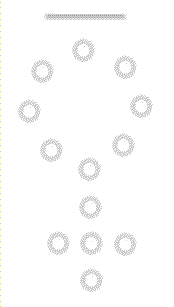
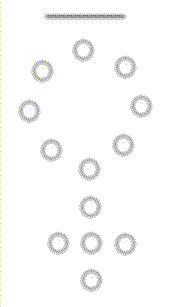
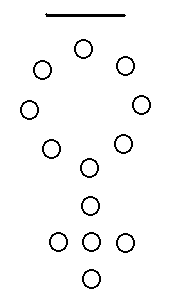
Even this model of a woman's approach to life is
not fully from a woman's point of view. Everything we have discussed so far is visible
from that shared territory in which both men and women find meaning. To take the final
step, we must leave our logic behind and think only with our hearts.
Rather than picturing a woman's goal as a
definitive thing, albeit one which emerges or comes into focus, consider a woman's
experience in life as one in which no final goal ever emerges at all. Instead, imagine a
continually changing progression of images that morph from one into another, never fully
being, but always in the process of becoming.
As we observe these images, some attract us, some
repel us, but never completely, for they never fully form. At one moment the progression
of our life exploration may have us feeling joy, but quickly turn to sadness or depression
because of some new element that enters the blend and spoils the mix.
Some images last longer than others. Those that are
most attractive pull us with greater force, but those that last longer carry greater
weight. Our orbit through life is guided by the combined influence of the intensity of
engery, and the gravity of mass.
Through those images that remain most constant, we
find security. They become our anchors in life. Through those that shine the brightes, we
find the pinacles of joy and the pits of depression. With grace and sharpened reflexes we
respond to the slight changes in the emotional wind, avoiding downdrafts and soaring on
thermals to new heights of ecstasy.
Men see us as fickle, unreasonable, and
directionless. We see ourselves as changable, sensitive, and responsive. Men see women as
avoiding clearly productive areas, and we see men as engaged in unfulfilling endeavors. We
cannot imagine how logic, by itself, could ever be more imporant than our feelings, and
men cannot imagine how any way of thinking they cannot see can have any true validity.
'Round and 'round we go - men and women, cheek to
cheek. But are we dancing or circling each other in the ring?
